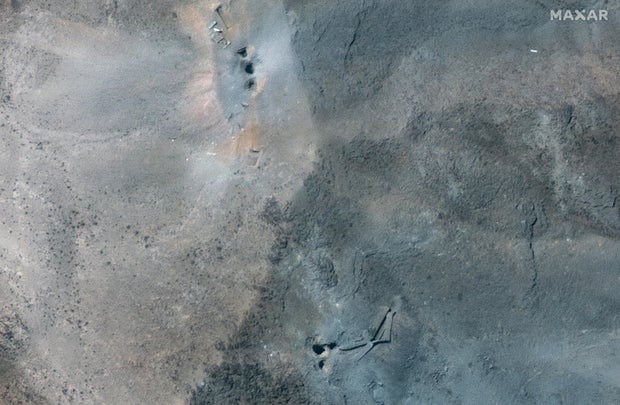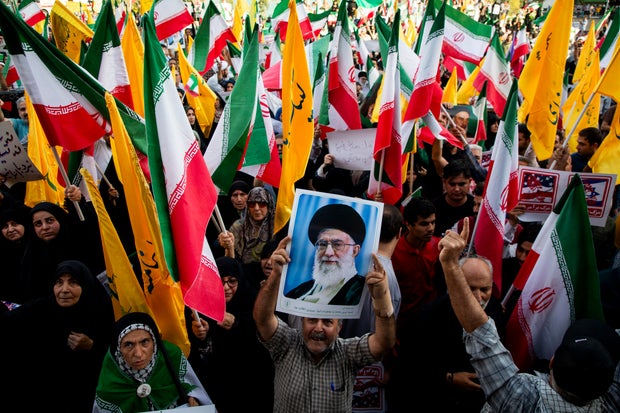Iran’s Ayatollah Khamenei issues claims of victory over Israel, “a big slap in the face” to the U.S.

“I offer my congratulations on the victory over the fallacious Zionist regime,” a message posted Thursday on Iranian Supreme Leader Ayatollah Ali Khamenei’s X account declared. Another post added the bold claim that Israel’s government “was practically knocked out and crushed under the blows of the Islamic Republic.”
In a recorded video address to his nation — his first public remarks since the U.S.-brokered ceasefire with Israel took effect on Tuesday — Khamenei went further, suggesting a “large number of military and other targets” in Israel had been targeted by Iran’s missiles.
They may have been targeted, but in reality, Iran’s 12 days of missile launches saw relatively few rockets evade Israel’s air defenses. A total of 28 people were killed, and none of them have been identified as government officials, but rather civilians killed when missiles struck apartment buildings and cities.
Israel’s strikes on Iran killed at least 30 military commanders, on the other hand, and, in combination with the U.S. strikes over the weekend, “obliterated” the country’s nuclear program, according to President Trump. The U.S.-based group Human Rights Activists in Iran, which relies on a network of sources in the country, said Wednesday that the strikes had killed at least 1,054 people in Iran, including a total of 318 military personnel.
Satellite image ©2025 Maxar Technologies
While full assessments of the damage inflicted are still being compiled, the heads of two U.S. intelligence agencies said Wednesday that “new” intelligence indicated the Iranian nuclear enrichment program was likely set back by “years.” Israeli Prime Minister Benjamin Netanyahu’s office said earlier Wednesday that the country’s own intelligence assessment showed Iran’s nuclear program was put back “many years.”
Khamenei had a very different take — again, offered without any specifics or evidence. He claimed the U.S. had joined in Israel’s strikes “as it felt if it did not do so, the Zionist regime would get totally annihilated, so they entered the war to prevent this.”
“They did not manage to do anything important to our nuclear facilities,” he claimed, adding that Mr. Trump had “overplayed the whole thing” and even that Iran had given “the U.S. a big slap in the face” by attacking the Al-Udeid Air Base in Qatar, which is home to thousands of American forces.
But none of the roughly dozen missiles Iran fired at the sprawling base hit it. They were intercepted, despite the ayatollah’s assertion of “lots of damage” to the site
Anxiety in Iran fueling the ayatollah’s dubious claims?
Khamenei’s remarks on Thursday were heavy on rhetorical flourish and virtually devoid of any facts, and they may have been aimed more at Iran’s people than the wider world.
Iran’s theocratic rulers, who swept to power with the 1979 Islamic Revolution that toppled a pro-Western government lead by the royal family of the shah, have long maintained tight control over all media in the country, and many Iranians have little access to outside information.
NEGAR/Middle East Images/AFP/Getty
Still, especially among younger, more tech-savvy generations, there is an understanding of the degree to which Iran’s people do not enjoy the freedoms that many other countries guarantee — and it has led to several popular protest uprisings over the last decade. All of them have been brutally quashed by the authorities, but Netanyahu called very quickly after Israel started bombing Iran for new anti-government protests in the country, urging Iranians to take advantage of the attacks, which he said had put the ayatollah in his weakest position ever.
Khamenei has yet to be seen live or in public since the ceasefire, and his precise whereabouts remained unclear Thursday after the pre-recorded video message was released.
While the ceasefire enabled Israelis to revel on Wednesday in a return to normalcy, with the lifting of 12 days of war-time security measures, in Tehran, anxiety still appeared rife.
CBS News correspondent Imtiaz Tyab and his team were granted Iranian visas to enter the country earlier in the week, and they were the first American broadcast network to enter Tehran since the war began. But it took them an arduous journey through arid landscapes and across the border from Turkey to reach Iran’s capital, as the country’s airspace had been closed.
Tyab said the Iranian capital felt very different this week compared to his previous visit about five years earlier, when, despite the government’s authoritarian control over daily life, it was a vibrant metropolis. On Thursday, despite the truce, most businesses remained shut, and the sense of nervousness was palpable.




